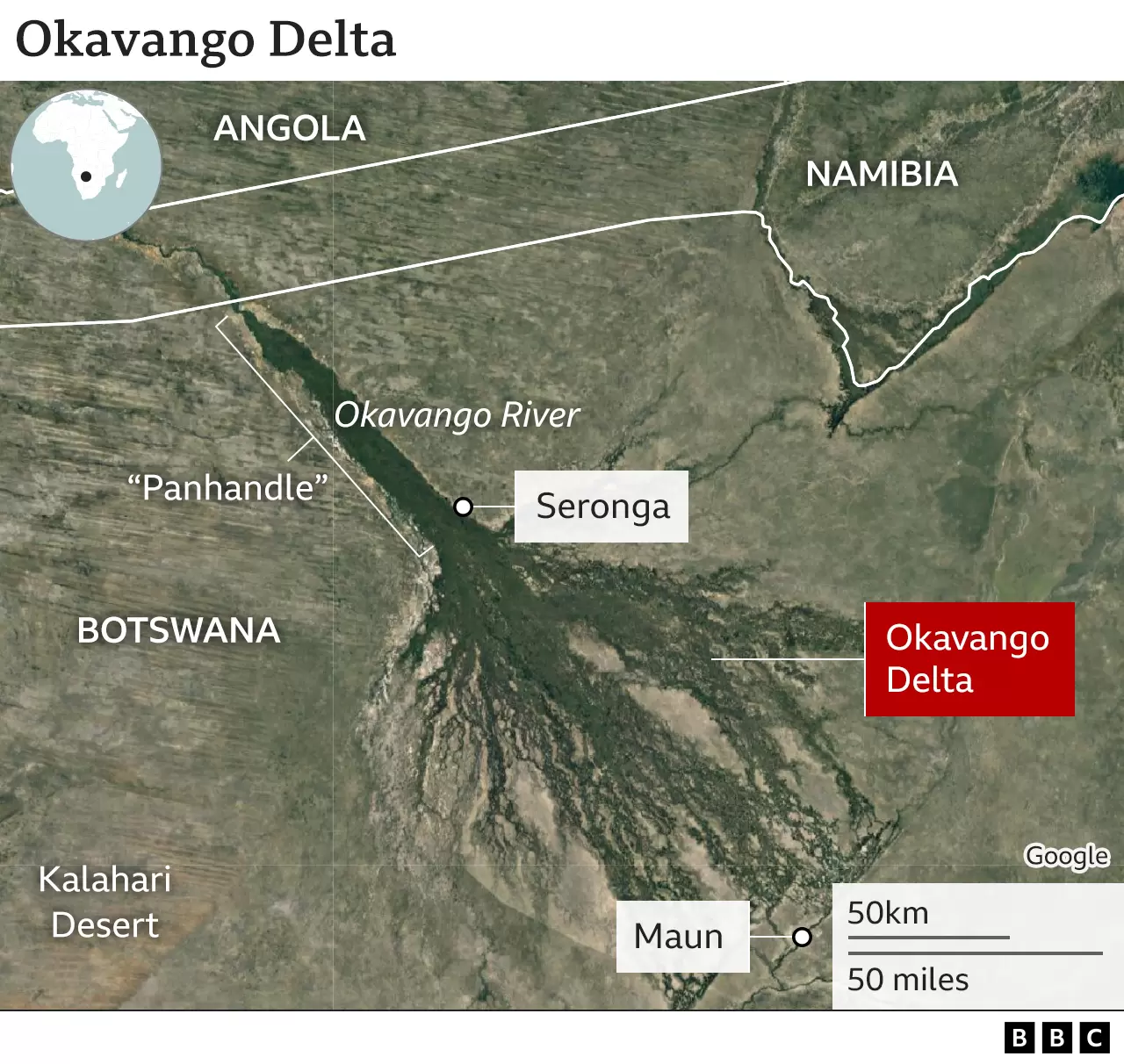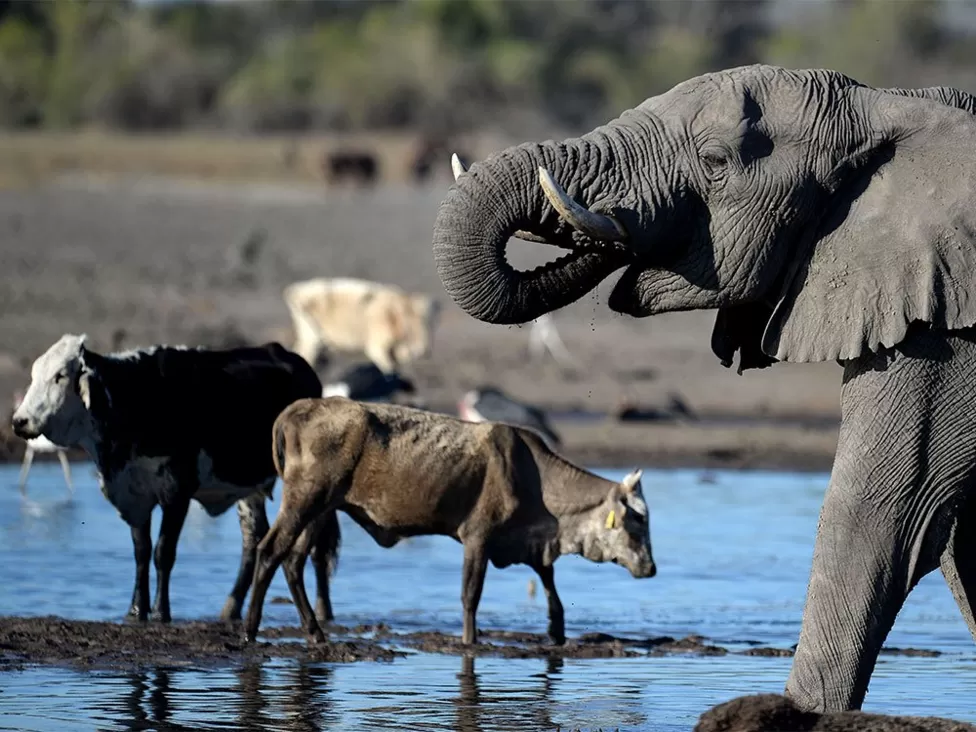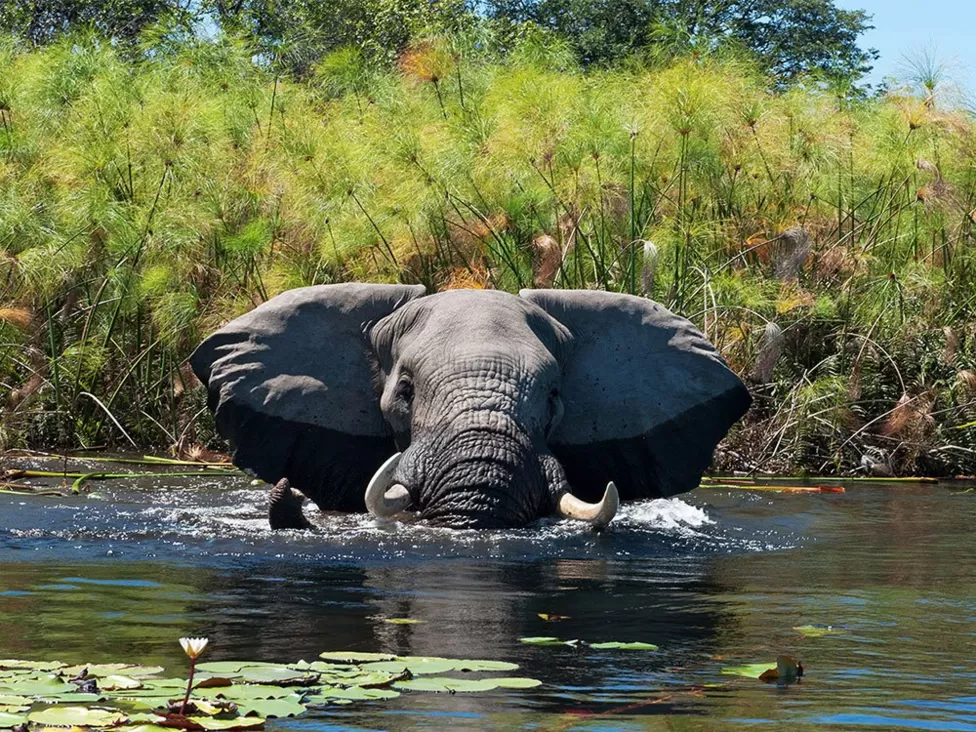With their large, padded feet, elephants can be remarkably quiet. It's our third evening of waiting to see these giants cross a dust road. Our guide, Mojita, assures us they're very close. "They're collecting just there, in the bush," he whispers.
We've been told: "It's elephant central up there, you'll see plenty of them." But so far there has been no sign of the actual animals, other than large piles of dung and prints in the sand.
"They're just there," Mojita whispers again.
I can hear and see nothing, other than trees and bushes.
We are at the top of the Okavango Delta in northern Botswana, standing in the middle of an "elephant corridor" - one of the regular routes taken by elephants in their daily commute between their feeding grounds on one side and water on the other.
"There!" Mojita points. And, yes, now I can hear the occasional low rumbling sounds - as I spot parts of a giant head peering at us through the bushes. "They can smell us," Mojita explains. "They're wary, they're going around [us]."
Then whoosh! About 100m away, dozens of elephants of all sizes burst from cover and dash across the road, into the bush on the other side. For the next few minutes, a whole herd crosses, some flapping their ears and trumpeting. They are warning each other and us to keep away, Mojita explains.
"You can tell with the speed that they move as they go to the river, that they [don't want] to be disturbed," says Mojita in hushed tones. "They're thirsty and just need to go and drink some water… It can be very dangerous. With the speed they're going, they don't even see what's going on, they just go straight."
Over the next quarter of an hour about 150 elephants cross the road. The last two are slower-moving, a mother with her one-week-old baby. It is exhilarating to see them in the wild like this and to experience them so close up. Thankfully, as Mojita explains, their keen sense of smell keeps them a safe distance from us

Every year at least one person is killed by elephants in this area. Warning signs by the roadside mark out the elephant corridors, so the locals know to keep clear of their usual paths. Part of a government initiative, the signs were put up with help from Mojita's employer, the Ecoexist Trust.
Ecoexist works in 14 villages along a 75 mile (120km) stretch of road, in the so-called Okavango Panhandle. This long, thin stretch of land and water opens into the world's largest inland delta, a green jewel in the Kalahari Desert. The trust's mission is to make elephants an asset, rather than a threat, for local people.

A hundred years ago, about 10 million elephants roamed the continent. Poaching, habitat loss and disease mean there are now fewer than half a million left in Africa - and roughly a third of them are in Botswana.
Experts say the elephant population in the country is increasing at a rate of 6% a year - about as fast as it can biologically grow.
As a result, the Botswanan government controversially lifted the ban on elephant hunting in 2019. It argues that it provides a good source of income for the local community - and says trophy hunting is licensed and strictly controlled.
In this area, near the village of Seronga, elephants outnumber people. But that can pose problems, especially for local subsistence farmers. A crop raid by elephants can destroy a family's annual food supply in just one night.

Farmers take simple measures to keep the elephants out, hanging strings of tin cans, plastic bottles, even plastic bags from wires around their fields. More recently, chilli "fences" (chilli-infused cloths hanging from a metal wire) and "beehive fences" have been introduced. Elephants really do not like buzzing bees.
"You need a whole range of techniques," Mojita explains. "An elephant can come and observe the tin-can fence and see if there is any movement or if it's harmful… It will learn and, at one point, it will end up breaking through and coming in."
That's what happened to Dimbo Kagidizoro. He greets us dressed in his best suit and shoes and shows us around his land. Ten people depend on the crops he grows. One night last month he was woken by the sound of elephants. "I banged my drum to scare them away," Dimbo says. "I banged and banged and banged. Then I heard a crash."
Once the elephants had gone, he went out and discovered the damage. They had pulled down and destroyed his prized and most expensive possession: a large, round, green plastic water tank.
About 2m (6.5ft) across, the tank held 5,000 litres of water, hoisted up on some stilts under a tree. Dimbo used it to irrigate his vegetable plot. Now it lies in pieces on the ground. He might get some minimal compensation from the government, but it won't pay for a new tank.

"You can shoot elephants if you catch them on your land," Dimbo says. He may have suffered recently, but he says he understands that elephants do bring benefits to the local area, because they attract tourists, which creates local jobs. In turn, that provides a market for any surplus vegetables he grows.
A few miles down the road, we meet Bycheni Kapande who lives in one of the villages where Ecoexist works. She sings and dances as part of a group called Living with Elephants, which performs traditional songs for tourists. The day after our visit, a group was to be flown in by helicopter to be entertained by Bycheni and other villagers. "My children can put on uniforms to go to school, and I have money to buy food, so elephants have brought good things," she says. "The community is improving."
But bringing up children around such large creatures can also be daunting. To allay the fears of parents, Ecoexist has found backing for a minibus service, the Elephant Express, which ferries children to school safely across those elephant corridors

The trust also pays local farmers a premium price for their millet if they promise to protect elephants.
The millet is used in a craft brewery set up in the town of Maun, making beer for thirsty tourists.
All this is part of what's known as the "elephant economy" - local people earning money from elephants and growing to appreciate these large, sometimes destructive, mammals

On the dust road, Mojita scans the trees and bushes with binoculars, looking out for more elephants. A couple of young women walk past. With population growth on both sides - human and elephant - keeping the peace could become increasingly difficult, he admits.
"If we don't mitigate the situation now, we may end up with a situation of elephants killing people and people killing elephants… because they'll be fighting for limited resources."
There are other potential dangers on the horizon.
Willemien le Roux has lived on the banks of a lagoon on the western shores of the delta for more than 30 years "The river has changed," Willemien says. "It used to be the most clear stream... you could see the hippo tracks on the bottom. These days the water remains murky… the fish numbers seem to decline, the floods come at a different time and it doesn't reach the peaks it used to."
Hydrologists worry that major dam and irrigation projects upriver in Angola could seriously impact the flow of water to the delta. That would damage this precious ecosystem, including the people and elephants that depend upon it.
For now, though, the immediate challenge is to keep the peace between people and elephants. So far, at least in the Seronga area, the signs are positive.

"Co-existence is something we want to see happening," says Mojita. "Because this place is for elephants and humans as well… We need to educate people because it's easier to live with [elephants] if you understand [them]. We need to start now and build for the future."